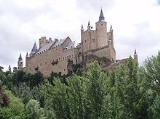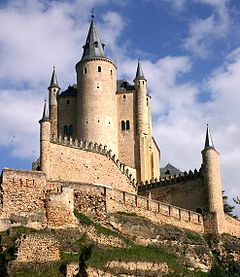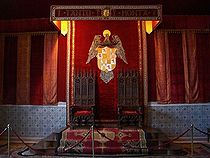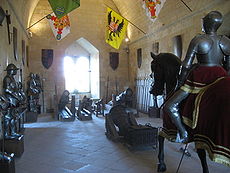
Alcázar of Segovia
Encyclopedia
The Alcázar of Segovia is a stone fortification, located in the old city of Segovia
, Spain. Rising out on a rocky crag above the confluence of the rivers Eresma and Clamores near the Guadarrama
mountains, it is one of the most distinctive castle-palaces in Spain by virtue of its shape - like the bow of a ship. The Alcázar was originally built as a fortress but has served as a royal palace, a state prison, a Royal Artillery College and a military academy since then.
The Alcázar of Segovia, like many fortifications in Spain, started off as an Arab
fort, but little of that structure remains. The first reference to this particular Alcázar was in 1120, around 32 years after the city of Segovia returned to Christian
hands (during the time when Alfonso VI of León and Castile reconquered lands to the south of the Duero river down to Toledo
and beyond). However, archaeological evidence suggests that the site of this Alcázar was once used in Roman times as a fortification. This theory is further substantiated by the presence of Segovia's famous Roman Aqueduct
.
The shape and form of the Alcázar was not known until the reign of King Alfonso VIII
(1155–1214), however early documentation mentioned a wooden stockade fence. It can be concluded that prior to Alfonso VIII's reign, it was no more than a wooden fort built over the old Roman foundations. Alfonso VIII and his wife, Eleanor of Plantagenet
made this Alcázar their principal residence and much work was carried out to erect the beginnings of the stone fortification we see today.
 The Alcázar, throughout the Middle Age
The Alcázar, throughout the Middle Age
s, remained one of the favorite residences of the monarchs of the Kingdom of Castile
and a key fortress in the defense of the kingdom. It was during this period a majority of the current building was constructed and the palace was extended on a large scale by the monarchs of the Trastámara
dynasty.
In 1258, parts of the Alcázar had to be rebuilt by King Alfonso X of Castile
after a cave-in and soon after the Hall of Kings was built to house Parliament. However, the single largest contributor to the continuing construction of the Alcázar is King John II
which built the 'New Tower' (John II tower as it is known today).
 In 1474, the Alcázar played a major role in the rise of Queen Isabella I of Castile
In 1474, the Alcázar played a major role in the rise of Queen Isabella I of Castile
. On the 12th December news of the King Henry IV
's death in Madrid reached Segovia and Isabella immediately took refuge within the walls of this Alcázar where she received the support of Andres Cabrera and Segovia's council. She was crowned the next day as Queen of Castile and León.
The next major renovation at the Alcázar was conducted by King Philip II
after his marriage to Anna of Austria. He added the sharp slate spires to reflect the castles of central Europe. In 1587, architect Francisco de Morar completed the main garden and the School of Honor areas of the castle.
The royal court eventually moved to Madrid and the Alcázar then served as a state prison for almost two centuries before King Charles III
founded the Royal Artillery School in 1762. It served this function for almost a hundred years until March 6, 1862 where a fire badly damaged the roofs and framework.
 It was only in 1882 that the building was slowly restored to its original state. In 1896, King Alfonso XIII
It was only in 1882 that the building was slowly restored to its original state. In 1896, King Alfonso XIII
ordered the Alcázar to be handed over to the Ministry of War as a military college.
Today, the Alcázar remains one of the most popular historical sights in Spain and is one of the three major attractions in Segovia. Notable rooms are the Hall of Ajimeces which houses many works of art, the Hall of the Throne and the Hall of Kings with a frieze representing all of the Spanish Kings and Queens starting from Pelagius of Asturias down to Juana la Loca after moving to El Palacio Real in Madrid, Spain.
Segovia
Segovia is a city in Spain, the capital of Segovia Province in the autonomous community of Castile and León. It is situated north of Madrid, 30 minutes by high speed train. The municipality counts some 55,500 inhabitants.-Etymology:...
, Spain. Rising out on a rocky crag above the confluence of the rivers Eresma and Clamores near the Guadarrama
Guadarrama
Guadarrama is a town in the Community of Madrid in Spain.Pop: 13032 , approx. 60000 .Co-ordinates . not true...
mountains, it is one of the most distinctive castle-palaces in Spain by virtue of its shape - like the bow of a ship. The Alcázar was originally built as a fortress but has served as a royal palace, a state prison, a Royal Artillery College and a military academy since then.
The Alcázar of Segovia, like many fortifications in Spain, started off as an Arab
Arab
Arab people, also known as Arabs , are a panethnicity primarily living in the Arab world, which is located in Western Asia and North Africa. They are identified as such on one or more of genealogical, linguistic, or cultural grounds, with tribal affiliations, and intra-tribal relationships playing...
fort, but little of that structure remains. The first reference to this particular Alcázar was in 1120, around 32 years after the city of Segovia returned to Christian
Christian
A Christian is a person who adheres to Christianity, an Abrahamic, monotheistic religion based on the life and teachings of Jesus of Nazareth as recorded in the Canonical gospels and the letters of the New Testament...
hands (during the time when Alfonso VI of León and Castile reconquered lands to the south of the Duero river down to Toledo
Toledo, Spain
Toledo's Alcázar became renowned in the 19th and 20th centuries as a military academy. At the outbreak of the Spanish Civil War in 1936 its garrison was famously besieged by Republican forces.-Economy:...
and beyond). However, archaeological evidence suggests that the site of this Alcázar was once used in Roman times as a fortification. This theory is further substantiated by the presence of Segovia's famous Roman Aqueduct
Aqueduct of Segovia
The Aqueduct of Segovia is a Roman aqueduct and one of the most significant and best-preserved ancient monuments left on the Iberian Peninsula...
.
The shape and form of the Alcázar was not known until the reign of King Alfonso VIII
Alfonso VIII of Castile
Alfonso VIII , called the Noble or el de las Navas, was the King of Castile from 1158 to his death and King of Toledo. He is most remembered for his part in the Reconquista and the downfall of the Almohad Caliphate...
(1155–1214), however early documentation mentioned a wooden stockade fence. It can be concluded that prior to Alfonso VIII's reign, it was no more than a wooden fort built over the old Roman foundations. Alfonso VIII and his wife, Eleanor of Plantagenet
Leonora of England
Eleanor of England was Queen of Castile and Toledo as wife of Alfonso VIII of Castile. She was a daughter of Henry II of England and his wife, Duchess Eleanor of Aquitaine.-Early life:...
made this Alcázar their principal residence and much work was carried out to erect the beginnings of the stone fortification we see today.

Middle age
Middle age is the period of age beyond young adulthood but before the onset of old age. Various attempts have been made to define this age, which is around the third quarter of the average life span of human beings....
s, remained one of the favorite residences of the monarchs of the Kingdom of Castile
Kingdom of Castile
Kingdom of Castile was one of the medieval kingdoms of the Iberian Peninsula. It emerged as a political autonomous entity in the 9th century. It was called County of Castile and was held in vassalage from the Kingdom of León. Its name comes from the host of castles constructed in the region...
and a key fortress in the defense of the kingdom. It was during this period a majority of the current building was constructed and the palace was extended on a large scale by the monarchs of the Trastámara
Trastámara
The House of Trastámara was a dynasty of kings in the Iberian Peninsula, which first governed in Castile beginning in 1369 before expanding its rule into Aragón, Navarre and Naples.They were a cadet illegitimate line of the House of Burgundy....
dynasty.
In 1258, parts of the Alcázar had to be rebuilt by King Alfonso X of Castile
Alfonso X of Castile
Alfonso X was a Castilian monarch who ruled as the King of Castile, León and Galicia from 1252 until his death...
after a cave-in and soon after the Hall of Kings was built to house Parliament. However, the single largest contributor to the continuing construction of the Alcázar is King John II
John II of Castile
John II was King of Castile from 1406 to 1454.He was the son of Henry III of Castile and his wife Catherine of Lancaster, daughter of John of Gaunt, 1st Duke of Lancaster by Constance of Castile, daughter of King Peter of Castile.-Regency:He succeeded his father on 25 December 1406, at the age of...
which built the 'New Tower' (John II tower as it is known today).

Isabella I of Castile
Isabella I was Queen of Castile and León. She and her husband Ferdinand II of Aragon brought stability to both kingdoms that became the basis for the unification of Spain. Later the two laid the foundations for the political unification of Spain under their grandson, Charles V, Holy Roman Emperor...
. On the 12th December news of the King Henry IV
Henry IV of Castile
Henry IV , King of the Crown of Castile, nicknamed the Impotent , was the last of the weak late medieval kings of Castile...
's death in Madrid reached Segovia and Isabella immediately took refuge within the walls of this Alcázar where she received the support of Andres Cabrera and Segovia's council. She was crowned the next day as Queen of Castile and León.
The next major renovation at the Alcázar was conducted by King Philip II
Philip II of Spain
Philip II was King of Spain, Portugal, Naples, Sicily, and, while married to Mary I, King of England and Ireland. He was lord of the Seventeen Provinces from 1556 until 1581, holding various titles for the individual territories such as duke or count....
after his marriage to Anna of Austria. He added the sharp slate spires to reflect the castles of central Europe. In 1587, architect Francisco de Morar completed the main garden and the School of Honor areas of the castle.
The royal court eventually moved to Madrid and the Alcázar then served as a state prison for almost two centuries before King Charles III
Charles III of Spain
Charles III was the King of Spain and the Spanish Indies from 1759 to 1788. He was the eldest son of Philip V of Spain and his second wife, the Princess Elisabeth Farnese...
founded the Royal Artillery School in 1762. It served this function for almost a hundred years until March 6, 1862 where a fire badly damaged the roofs and framework.

Alfonso XIII of Spain
Alfonso XIII was King of Spain from 1886 until 1931. His mother, Maria Christina of Austria, was appointed regent during his minority...
ordered the Alcázar to be handed over to the Ministry of War as a military college.
Today, the Alcázar remains one of the most popular historical sights in Spain and is one of the three major attractions in Segovia. Notable rooms are the Hall of Ajimeces which houses many works of art, the Hall of the Throne and the Hall of Kings with a frieze representing all of the Spanish Kings and Queens starting from Pelagius of Asturias down to Juana la Loca after moving to El Palacio Real in Madrid, Spain.

